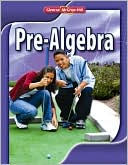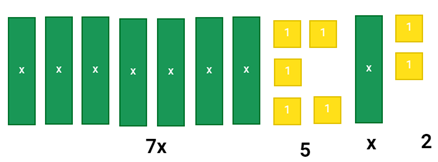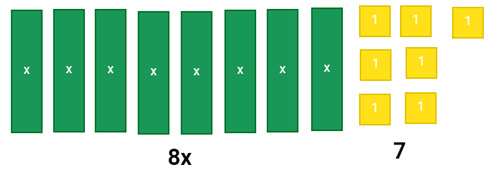
Pre-Algebra, Student Edition
1st Edition
ISBN: 9780078885150
Author: McGraw-Hill
Publisher: Glencoe/McGraw-Hill
expand_more
expand_more
format_list_bulleted
Question
Chapter 14.2, Problem 6PPS
To determine
Subtract the given equations,
( 7x +5) + ( x +2)
Expert Solution & Answer
Explanation of Solution
Given information:
Polynomials,
( 7x +5) + ( x +2)
Formula used: Algebra Tiles
Calculation:
Opening the bracket of the given equation,
7x +5 + x +2
Here, 7x is represented by 7 green tiles, 5 is represented by 5 yellow tiles, x is represented by a green tile and 2 is represented by 2 yellow tiles.

On solving, 7x and x adds and 5 and 2 adds.

Result, is 8x+7
Chapter 14 Solutions
Pre-Algebra, Student Edition
Ch. 14.1 - Prob. 1ACYPCh. 14.1 - Prob. 1BCYPCh. 14.1 - Prob. 2ACYPCh. 14.1 - Prob. 2BCYPCh. 14.1 - Prob. 3ACYPCh. 14.1 - Prob. 3BCYPCh. 14.1 - Prob. 4CYPCh. 14.1 - Prob. 1CYUCh. 14.1 - Prob. 2CYUCh. 14.1 - Prob. 3CYU
Ch. 14.1 - Prob. 4CYUCh. 14.1 - Prob. 5CYUCh. 14.1 - Prob. 6CYUCh. 14.1 - Prob. 7CYUCh. 14.1 - Prob. 8CYUCh. 14.1 - Prob. 9CYUCh. 14.1 - Prob. 10PPSCh. 14.1 - Prob. 11PPSCh. 14.1 - Prob. 12PPSCh. 14.1 - Prob. 13PPSCh. 14.1 - Prob. 14PPSCh. 14.1 - Prob. 15PPSCh. 14.1 - Prob. 16PPSCh. 14.1 - Prob. 17PPSCh. 14.1 - Prob. 18PPSCh. 14.1 - Prob. 19PPSCh. 14.1 - Prob. 20PPSCh. 14.1 - Prob. 21PPSCh. 14.1 - Prob. 22PPSCh. 14.1 - Prob. 23PPSCh. 14.1 - Prob. 24PPSCh. 14.1 - Prob. 25PPSCh. 14.1 - Prob. 26PPSCh. 14.1 - Prob. 27PPSCh. 14.1 - Prob. 28PPSCh. 14.1 - Prob. 29PPSCh. 14.1 - Prob. 30PPSCh. 14.1 - Prob. 31PPSCh. 14.1 - Prob. 32PPSCh. 14.1 - Prob. 33PPSCh. 14.1 - Prob. 34HPCh. 14.1 - Prob. 35HPCh. 14.1 - Prob. 36HPCh. 14.1 - Prob. 37HPCh. 14.2 - Prob. 1ACYPCh. 14.2 - Prob. 1BCYPCh. 14.2 - Prob. 2ACYPCh. 14.2 - Prob. 2BCYPCh. 14.2 - Prob. 3CYPCh. 14.2 - Prob. 1CYUCh. 14.2 - Prob. 2CYUCh. 14.2 - Prob. 3CYUCh. 14.2 - Prob. 4CYUCh. 14.2 - Prob. 5CYUCh. 14.2 - Prob. 6PPSCh. 14.2 - Prob. 7PPSCh. 14.2 - Prob. 8PPSCh. 14.2 - Prob. 9PPSCh. 14.2 - Prob. 10PPSCh. 14.2 - Prob. 11PPSCh. 14.2 - Prob. 12PPSCh. 14.2 - Prob. 13PPSCh. 14.2 - Prob. 14PPSCh. 14.2 - Prob. 15PPSCh. 14.2 - Prob. 16PPSCh. 14.2 - Prob. 17PPSCh. 14.2 - Prob. 18HPCh. 14.2 - Prob. 19HPCh. 14.2 - Prob. 20HPCh. 14.2 - Prob. 21HPCh. 14.3 - Prob. 1ACYPCh. 14.3 - Prob. 1BCYPCh. 14.3 - Prob. 2CYPCh. 14.3 - Prob. 3CYPCh. 14.3 - Prob. 1CYUCh. 14.3 - Prob. 2CYUCh. 14.3 - Prob. 3CYUCh. 14.3 - Prob. 4CYUCh. 14.3 - Prob. 5CYUCh. 14.3 - Prob. 6PPSCh. 14.3 - Prob. 7PPSCh. 14.3 - Prob. 8PPSCh. 14.3 - Prob. 9PPSCh. 14.3 - Prob. 10PPSCh. 14.3 - Prob. 11PPSCh. 14.3 - Prob. 12PPSCh. 14.3 - Prob. 13PPSCh. 14.3 - Prob. 14PPSCh. 14.3 - Prob. 15HPCh. 14.3 - Prob. 16HPCh. 14.3 - Prob. 17HPCh. 14.4 - Prob. 1CYUCh. 14.4 - Prob. 2CYUCh. 14.4 - Prob. 3CYUCh. 14.4 - Prob. 4CYUCh. 14.4 - Prob. 5CYUCh. 14.4 - Prob. 6CYUCh. 14.4 - Prob. 7CYUCh. 14.4 - Prob. 8CYUCh. 14.4 - Prob. 9CYUCh. 14.4 - Prob. 10CYUCh. 14.4 - Prob. 11CYUCh. 14.4 - Prob. 12PPSCh. 14.4 - Prob. 13PPSCh. 14.4 - Prob. 14PPSCh. 14.4 - Prob. 15PPSCh. 14.4 - Prob. 16PPSCh. 14.4 - Prob. 17PPSCh. 14.4 - Prob. 18PPSCh. 14.4 - Prob. 19PPSCh. 14.4 - Prob. 20PPSCh. 14.4 - Prob. 21PPSCh. 14.4 - Prob. 22PPSCh. 14.4 - Prob. 23PPSCh. 14.4 - Prob. 24PPSCh. 14.4 - Prob. 25PPSCh. 14.4 - Prob. 26PPSCh. 14.4 - Prob. 27PPSCh. 14.4 - Prob. 28PPSCh. 14.4 - Prob. 29PPSCh. 14.4 - Prob. 30HPCh. 14.4 - Prob. 31HPCh. 14.4 - Prob. 32HPCh. 14.4 - Prob. 33HPCh. 14.4 - Prob. 34HPCh. 14.5 - Prob. 1ACYPCh. 14.5 - Prob. 1BCYPCh. 14.5 - Prob. 2ACYPCh. 14.5 - Prob. 2BCYPCh. 14.5 - Prob. 3CYPCh. 14.5 - Prob. 1CYUCh. 14.5 - Prob. 2CYUCh. 14.5 - Prob. 3CYUCh. 14.5 - Prob. 4CYUCh. 14.5 - Prob. 5CYUCh. 14.5 - Prob. 6CYUCh. 14.5 - Prob. 7CYUCh. 14.5 - Prob. 8CYUCh. 14.5 - Prob. 9CYUCh. 14.5 - Prob. 10CYUCh. 14.5 - Prob. 11PPSCh. 14.5 - Prob. 12PPSCh. 14.5 - Prob. 13PPSCh. 14.5 - Prob. 14PPSCh. 14.5 - Prob. 15PPSCh. 14.5 - Prob. 16PPSCh. 14.5 - Prob. 17PPSCh. 14.5 - Prob. 18PPSCh. 14.5 - Prob. 19PPSCh. 14.5 - Prob. 20PPSCh. 14.5 - Prob. 21PPSCh. 14.5 - Prob. 22PPSCh. 14.5 - Prob. 23PPSCh. 14.5 - Prob. 24PPSCh. 14.5 - Prob. 25PPSCh. 14.5 - Prob. 26PPSCh. 14.5 - Prob. 27PPSCh. 14.5 - Prob. 28PPSCh. 14.5 - Prob. 29PPSCh. 14.5 - Prob. 30PPSCh. 14.5 - Prob. 31PPSCh. 14.5 - Prob. 32PPSCh. 14.5 - Prob. 33PPSCh. 14.5 - Prob. 34PPSCh. 14.5 - Prob. 35PPSCh. 14.5 - Prob. 36PPSCh. 14.5 - Prob. 37HPCh. 14.5 - Prob. 38HPCh. 14.5 - Prob. 39HPCh. 14.5 - Prob. 40HPCh. 14.6 - Prob. 1ACYPCh. 14.6 - Prob. 1BCYPCh. 14.6 - Prob. 2CYPCh. 14.6 - Prob. 1CYUCh. 14.6 - Prob. 2CYUCh. 14.6 - Prob. 3CYUCh. 14.6 - Prob. 4CYUCh. 14.6 - Prob. 5CYUCh. 14.6 - Prob. 6CYUCh. 14.6 - Prob. 7CYUCh. 14.6 - Prob. 8CYUCh. 14.6 - Prob. 9CYUCh. 14.6 - Prob. 10CYUCh. 14.6 - Prob. 11CYUCh. 14.6 - Prob. 12CYUCh. 14.6 - Prob. 13PPSCh. 14.6 - Prob. 14PPSCh. 14.6 - Prob. 15PPSCh. 14.6 - Prob. 16PPSCh. 14.6 - Prob. 17PPSCh. 14.6 - Prob. 18PPSCh. 14.6 - Prob. 19PPSCh. 14.6 - Prob. 20PPSCh. 14.6 - Prob. 21PPSCh. 14.6 - Prob. 22PPSCh. 14.6 - Prob. 23HPCh. 14.6 - Prob. 24HPCh. 14.6 - Prob. 25HPCh. 14.6 - Prob. 26HPCh. 14.6 - Prob. 27HPCh. 14.7 - Prob. 1ACYPCh. 14.7 - Prob. 1BCYPCh. 14.7 - Prob. 1CCYPCh. 14.7 - Prob. 1DCYPCh. 14.7 - Prob. 2ACYPCh. 14.7 - Prob. 2BCYPCh. 14.7 - Prob. 3CYPCh. 14.7 - Prob. 1CYUCh. 14.7 - Prob. 2CYUCh. 14.7 - Prob. 3CYUCh. 14.7 - Prob. 4CYUCh. 14.7 - Prob. 5CYUCh. 14.7 - Prob. 6CYUCh. 14.7 - Prob. 7CYUCh. 14.7 - Prob. 8PPSCh. 14.7 - Prob. 9PPSCh. 14.7 - Prob. 10PPSCh. 14.7 - Prob. 11PPSCh. 14.7 - Prob. 12PPSCh. 14.7 - Prob. 13PPSCh. 14.7 - Prob. 14PPSCh. 14.7 - Prob. 15PPSCh. 14.7 - Prob. 16HPCh. 14.7 - Prob. 17HPCh. 14.7 - Prob. 18HPCh. 14.7 - Prob. 19HPCh. 14.8 - Prob. 1ACYPCh. 14.8 - Prob. 1BCYPCh. 14.8 - Prob. 2ACYPCh. 14.8 - Prob. 2BCYPCh. 14.8 - Prob. 3CYPCh. 14.8 - Prob. 1CYUCh. 14.8 - Prob. 2CYUCh. 14.8 - Prob. 3CYUCh. 14.8 - Prob. 4CYUCh. 14.8 - Prob. 5CYUCh. 14.8 - Prob. 6CYUCh. 14.8 - Prob. 7CYUCh. 14.8 - Prob. 8PPSCh. 14.8 - Prob. 9PPSCh. 14.8 - Prob. 10PPSCh. 14.8 - Prob. 11PPSCh. 14.8 - Prob. 12PPSCh. 14.8 - Prob. 13PPSCh. 14.8 - Prob. 14PPSCh. 14.8 - Prob. 15PPSCh. 14.8 - Prob. 16PPSCh. 14.8 - Prob. 17PPSCh. 14.8 - Prob. 18PPSCh. 14.8 - Prob. 19PPSCh. 14.8 - Prob. 20HPCh. 14.8 - Prob. 21HPCh. 14.8 - Prob. 22HPCh. 14.8 - Prob. 23HP
Additional Math Textbook Solutions
Find more solutions based on key concepts
Fill in each blanks so that the resulting statement is true. Any set of ordered pairs is called a/an _______. T...
College Algebra (7th Edition)
In Exercises 29–32, indicate whether the observational study used is cross-sectional, retrospective, or prospec...
Elementary Statistics (13th Edition)
8. Effect of Blinding Among 13,200 submitted abstracts that were blindly evaluated (with authors and institutio...
Elementary Statistics
Surfing College students and surfers Rex Robinson and Sandy Hudson collected data on the self-reported numbers ...
Introductory Statistics
CHECK POINT I You deposit $1000 in a saving account at a bank that has a rate of 4%. a. Find the amount, A, of ...
Thinking Mathematically (6th Edition)
Knowledge Booster
Learn more about
Need a deep-dive on the concept behind this application? Look no further. Learn more about this topic, algebra and related others by exploring similar questions and additional content below.Similar questions
- ??!!arrow_forwardrections: For problem rough 3, read each question carefully and be sure to show all work. 1. Determine if 9(4a²-4ab+b²) = (6a-3b)² is a polynomial identity. 2. Is (2x-y) (8x3+ y³) equivalent to 16x4-y4? 3. Find an expression that is equivalent to (a - b)³. Directions: For problems 4 and 5, algebraically prove that the following equations are polynomial identities. Show all of your work and explain each step. 4. (2x+5)² = 4x(x+5)+25 5. (4x+6y)(x-2y)=2(2x²-xy-6y²)arrow_forwardName: Mussels & bem A section of a river currently has a population of 20 zebra mussels. The population of zebra mussels increases 60 % each month. What will be the population of zebra mussels after 2 years? 9 10 # of months # of mussels 1 2 3 4 5 6 7 8 o Graph your data. Remember to title your graph. What scale should be used on the y-axis? What scale should be used on the x-axis? Exponential Growth Equation y = a(1+r)*arrow_forward
- In a national park, the current population of an endangered species of bear is 80. Each year, the population decreases by 10%. How can you model the population of bears in the park? # of years # of bears 9 10 2 3 4 5 6 7 8 ° 1 Graph your data. Remember to title your graph. What scale should be used on the y-axis? What scale should be used on the x-axis? SMOKY 19 OUNTAINS NATIONAL Exponential Decay Equation y = a(1-r)* PARKarrow_forwardOn Feb. 8, this year, at 6am in the morning all UiB meteorology professors met to discuss a highly unfortunate and top-urgent crisis: Their most precious instrument, responsible for measuring the air temperature hour-by- hour, had failed - what if the Bergen public would find out? How would they plan their weekend without up-to-date air temperature readings? Silent devastation - and maybe a hint of panic, also - hung in the room. Apprentice Taylor, who - as always - was late to the meeting, sensed that this was his chance to shine! Could they fake the data? At least for some hours (until the measurements would work again)? He used to spend a lot of time online and thus knew the value of fake data, especially when it spread fast! He reminded the crying professors of a prehistoric project with the title "Love your derivatives as you love yourself!" - back then, they had installed top-modern technology that not only measured the air temperature itself, but also its 1st, 2nd, 3rd, 4th, and…arrow_forwardConsider a forest where the population of a particular plant species grows exponentially. In a real-world scenario, we often deal with systems where the analytical function describing the phenomenon is not available. In such cases, numerical methods come in handy. For the sake of this task, however, you are provided with an analytical function so that you can compare the results of the numerical methods to some ground truth. The population P(t) of the plants at time t (in years) is given by the equation: P(t) = 200 0.03 t You are tasked with estimating the rate of change of the plant population at t = 5 years using numerical differentiation methods. First, compute the value of P'(t) at t = 5 analytically. Then, estimate P'(t) at t = 5 years using the following numerical differentiation methods: ⚫ forward difference method (2nd-order accurate) 3 ⚫ backward difference method (2nd-order accurate) ⚫ central difference method (2nd-order accurate) Use h = 0.5 as the step size and round all…arrow_forward
- Nicole organized a new corporation. The corporation began business on April 1 of year 1. She made the following expenditures associated with getting the corporation started: Expense Date Amount Attorney fees for articles of incorporation February 10 $ 40,500 March 1-March 30 wages March 30 6,550 March 1-March 30 rent Stock issuance costs March 30 2,850 April 1-May 30 wages Note: Leave no answer blank. Enter zero if applicable. April 1 May 30 24,000 16,375 c. What amount can the corporation deduct as amortization expense for the organizational expenditures and for the start-up costs for year 1 [not including the amount determined in part (b)]? Note: Round intermediate calculations to 2 decimal places and final answer to the nearest whole dollar amount. Start-up costs amortized Organizational expenditures amortizedarrow_forwardLast Chance Mine (LCM) purchased a coal deposit for $2,918,300. It estimated it would extract 18,950 tons of coal from the deposit. LCM mined the coal and sold it, reporting gross receipts of $1.24 million, $13 million, and $11 million for years 1 through 3, respectively. During years 1-3, LCM reported net income (loss) from the coal deposit activity in the amount of ($11,400), $550,000, and $502,500, respectively. In years 1-3, LCM extracted 19,950 tons of coal as follows: (1) Tons of Coal 18,950 Depletion (2) Basis (2)(1) Rate $2,918,300 $154.00 Tons Extracted per Year Year 1 4,500 Year 2 8,850 Year 3 6,600 Note: Leave no answer blank. Enter zero if applicable. Enter your answers in dollars and not in millions of dollars. a. What is LCM's cost depletion for years 1, 2, and 3? Cost Depletion Year 1 Year 2 Year 3arrow_forwardConsider the following equation. log1/9' =6 Find the value of x. Round your answer to the nearest thousandth. x = ✓arrow_forward
- Expanding a logarithmic expression: Problem type 3 Use the properties of logarithms to expand the following expression. 4(8+x)² log 5 ) Your answer should not have radicals or exponents. You may assume that all variables are positive. log 4(8 + X 5 -x)²arrow_forwardUse the properties of logarithms to expand the following expression. log 6(x+5)² 3/24 Your answer should not have radicals or exponents. You may assume that all variables are positive. log 6(x + 3 I 4 5)² log Xarrow_forwardExpanding a logarithmic expression: Problem type 2 Use the properties of logarithms to expand the following expression. 3 yz log 5 x 0/3 An Each logarithm should involve only one variable and should not have any radicals or exponents. You may assume that all variables are positive. log yz 3 厚 5 Explanation Check log ☑ 2025 MG ¿W MIII LLC. All Rights Reserved. Terms of Use | Privacy Centerarrow_forward
arrow_back_ios
SEE MORE QUESTIONS
arrow_forward_ios
Recommended textbooks for you
 Algebra and Trigonometry (6th Edition)AlgebraISBN:9780134463216Author:Robert F. BlitzerPublisher:PEARSON
Algebra and Trigonometry (6th Edition)AlgebraISBN:9780134463216Author:Robert F. BlitzerPublisher:PEARSON Contemporary Abstract AlgebraAlgebraISBN:9781305657960Author:Joseph GallianPublisher:Cengage Learning
Contemporary Abstract AlgebraAlgebraISBN:9781305657960Author:Joseph GallianPublisher:Cengage Learning Linear Algebra: A Modern IntroductionAlgebraISBN:9781285463247Author:David PoolePublisher:Cengage Learning
Linear Algebra: A Modern IntroductionAlgebraISBN:9781285463247Author:David PoolePublisher:Cengage Learning Algebra And Trigonometry (11th Edition)AlgebraISBN:9780135163078Author:Michael SullivanPublisher:PEARSON
Algebra And Trigonometry (11th Edition)AlgebraISBN:9780135163078Author:Michael SullivanPublisher:PEARSON Introduction to Linear Algebra, Fifth EditionAlgebraISBN:9780980232776Author:Gilbert StrangPublisher:Wellesley-Cambridge Press
Introduction to Linear Algebra, Fifth EditionAlgebraISBN:9780980232776Author:Gilbert StrangPublisher:Wellesley-Cambridge Press College Algebra (Collegiate Math)AlgebraISBN:9780077836344Author:Julie Miller, Donna GerkenPublisher:McGraw-Hill Education
College Algebra (Collegiate Math)AlgebraISBN:9780077836344Author:Julie Miller, Donna GerkenPublisher:McGraw-Hill Education

Algebra and Trigonometry (6th Edition)
Algebra
ISBN:9780134463216
Author:Robert F. Blitzer
Publisher:PEARSON

Contemporary Abstract Algebra
Algebra
ISBN:9781305657960
Author:Joseph Gallian
Publisher:Cengage Learning

Linear Algebra: A Modern Introduction
Algebra
ISBN:9781285463247
Author:David Poole
Publisher:Cengage Learning

Algebra And Trigonometry (11th Edition)
Algebra
ISBN:9780135163078
Author:Michael Sullivan
Publisher:PEARSON

Introduction to Linear Algebra, Fifth Edition
Algebra
ISBN:9780980232776
Author:Gilbert Strang
Publisher:Wellesley-Cambridge Press

College Algebra (Collegiate Math)
Algebra
ISBN:9780077836344
Author:Julie Miller, Donna Gerken
Publisher:McGraw-Hill Education
Implicit Differentiation Explained - Product Rule, Quotient & Chain Rule - Calculus; Author: The Organic Chemistry Tutor;https://www.youtube.com/watch?v=LGY-DjFsALc;License: Standard YouTube License, CC-BY